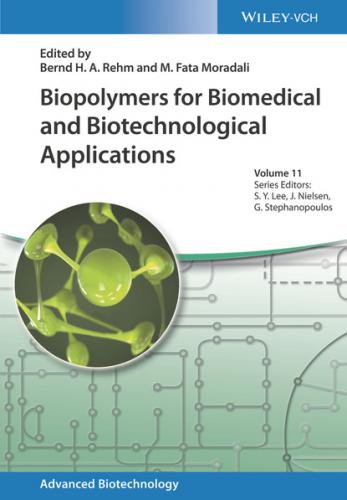Biopolymers for Biomedical and Biotechnological Applications. Группа авторов
to heat under an alternative magnetic field (for hyperthermia applications) [168,169]. The encapsulation of magnetic nanoparticles in a polymeric matrix (e.g. polyacrylamide) creates a thermoresponsive hydrogel. If this nanocomposite also contains a pharmaceutical drug, it could be used as a controlled release system. By applying an alternative magnetic field, the nanoparticles will increase their temperature changing the hydrogel structure to a more flexible state, allowing the easier delivery of the pharmaceutical substance [82]. In the previous examples, it has been established the importance of using polymeric matrices to produce nanomaterials with enhanced properties, as well as the potentialities of using these nanocomposites for medical applications.
More recently, it has been studied the use of biological polymers in the production of nanocomposites (bionanocomposites). The wide diversity of available natural polymers with distinct structures and properties has driven the interest toward the development of novel biopolymer nanocomposites with unique or improved functionalities. Unlike synthetic polymers, biopolymers have inherent favorable interaction with living systems [78]. Moreover, due to their chemical and structural diversity, biopolymers can provide excellent matrices for incorporation of different active substances (e.g. MNPs, hydrophilic and hydrophobic drugs), being more sustainable and having limited environmental impact due to their inherent biodegradability [80].
As previously mentioned, microbial polysaccharides have unique properties suitable to a wide range of applications. Some of these biopolymers are also known to have interactions with biological systems. These properties are usually associated with the composition of the polysaccharide. For instance, FucoPol is a biopolymer with potential antitumor and anti‐inflammatory properties due to its high fucose content. Fucose is a rare sugar with reported anticarcinogenic, antiaging, and anti‐inflammatory properties [4]. For these reasons, microbial polysaccharides can be used in the development of bionanocomposites not only as a matrix material due to their ability to form structured materials (e.g. hydrogels and films) but also as an active substance. This duality presented by the polysaccharides is an important feature for the development of bionanomaterials especially for biomedical applications [168,170].
Lately, the use of bionanocomposites with polysaccharides in several fields ranging from the degradation of pollutants to the development of hyperthermia agents and targeted delivery systems has been studied (Figure 2.4). For these types of applications, the biodegradability, the biocompatibility, and the biological response are important properties that can be easily attainable by using polysaccharides (especially from microbial origin) [172]. In Table 2.2, the use of distinct polysaccharides (all attainable through microbial production) and different MNPs for the development of nanocomposites for several applications has been shown. It is curious that the use of Au and Ag nanoparticles is usually associated with the production of nanocomposites with anticancer and antibacterial properties, respectively. Meanwhile, Fe3O4 nanoparticles are frequently related to the development of nanomaterials for drug delivery systems, hyperthermia, and contrast agents for MRI. Given this, the potentialities of the use of bionanocomposites with microbial polysaccharides especially in biomedicine remain well established.
Figure 2.4 Microbial polysaccharide‐based nanocomposites with metal nanoparticles for biotechnological applications.
Source: Adapted from Manivasagan and Oh 2016 [81] and Escárcega‐González et al. 2018 [171].
Table 2.2 Bionanocomposites containing polysaccharides and their applications.
| Polysaccharide | Nanoparticles | Possible applications | References |
|---|---|---|---|
| Hyaluronan | Fe3O4 | Contrast agents for MRI; drug delivery systems | [169] |
| Dextran | Fe3O4 | Cellular MRI and fluorescence imaging; drug delivery systems | [169] |
| Au0 | Anticancer agent | [171] | |
| Ag0 | Sensor for cysteine detection; antibacterial and antifungal agent | [169] | |
| Chitosan | Fe3O4 | Drug delivery systems | [169] |
| Cu0/Fe0/CdS | Degradation of Congo red and heavy metals in water (e.g. Cr(VI)) | [170] | |
| Fe3O4 | Contrast agents for MRI; hyperthermia agent | [168] | |
| Xanthan gum | Au0 | Drug delivery systems; anticancer therapy | [171] |
| Ag0 | Antibacterial and catalytic agent | [173] | |
| Pd/Fe | Soil remediation | [171] | |
| Gellan Gum | Au0 | Drug delivery systems; anticancer agent | [171] |
| Ag0 | Antibacterial and topical treatment | ||
| Fe3O4 | Drug delivery systems; anticancer agent |
MRI, magnetic resonance imaging.
Microbial polysaccharides show variability, versatility, stability, biocompatibility, and biodegradability. Adding to this, their important feature to act as a thickening, stabilizing, or binding agent makes them suitable to a wide range of applications, from food industry to pharmaceutical, medical, and cosmetic products. Moreover, since some of these biopolymers can form structured materials (such as gels and films), they could be used as matrices for the development of bionanocomposites with incorporated nanoparticles (Au0, Ag0, Fe3O4) for distinct applications in the biomedical field (anticancer, antibacterial, or hyperthermia agent, respectively). Polysaccharide‐based nanomaterials are an excellent source for nanotechnological applications in food, pharmaceutical, biomedicine, and cosmetic industries.
2.6 Bioactive Polysaccharides from Microalgae: An Emerging Area
Microalgae (including cyanobacteria) can use CO2 as carbon source and incorporate it in complex organic molecules, accounting for nearly half of CO2 capture by photosynthetic organisms annually. Their growth requirements are quite simple: a seawater medium supplemented with a source of nitrogen (apart from nitrogen‐fixing microorganisms), phosphate, iron, magnesium, calcium, and other minor salts [174]. As photosynthetic organisms, no carbon source
